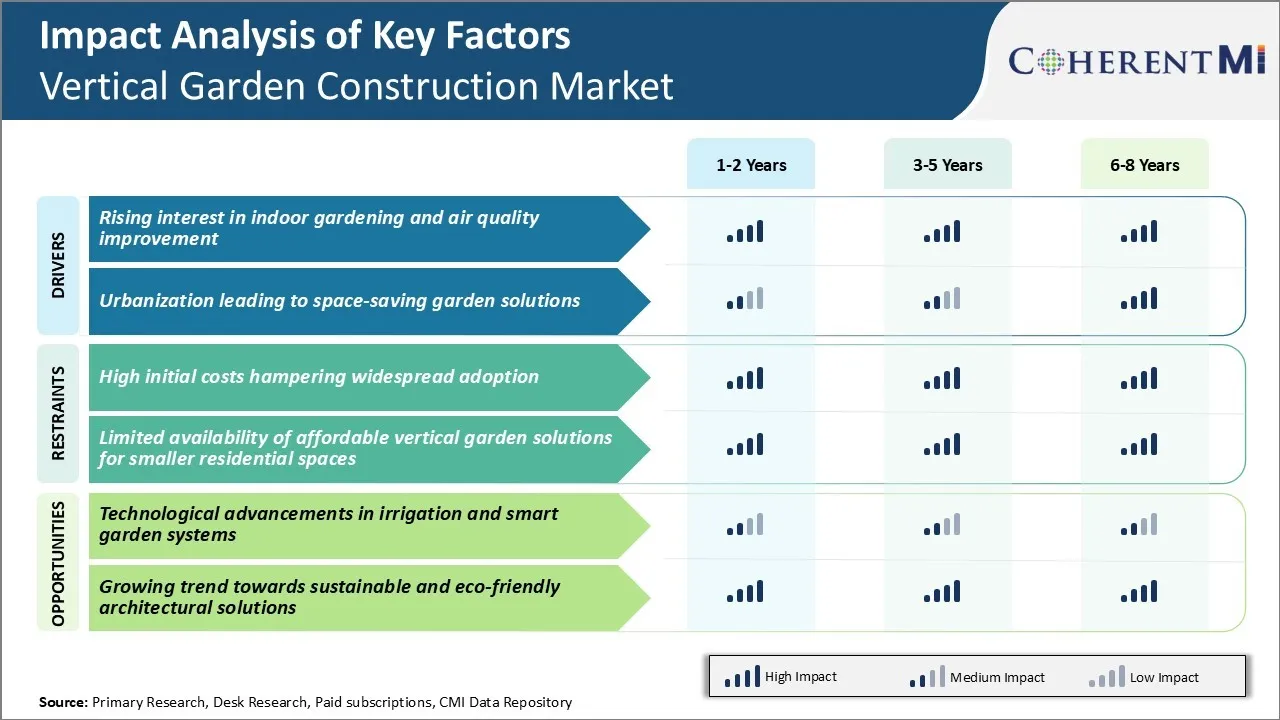Vertical Garden Construction Market Trends
Market Driver - Rising Interest in Indoor Gardening and Air Quality Improvement
With more and more people living in urban areas, green spaces are increasingly hard to find. At the same time, there is a growing trend of people wanting to be closer to nature. Indoor air quality is another major concern in tightly packed urban environments.
Vertical gardens help cleanse the air and add moisture. Plants are natural air purifiers that absorb toxins like formaldehyde from furniture and volatile organic compounds from cleaning products, carpeting and paint. Their photosynthetic process also releases oxygen. Their wall-mounted, compact designs, vertical gardens provide an aesthetically pleasing solution to improve air quality without taking up much space.
The pandemic has further accelerated this growing interest in indoor gardening and wellness. Being confined to their homes for long periods, more people felt the need to bring nature indoors and invest in their mental and physical health. Thereby, vertical gardens have emerged as a sustainable home solution that serves both functional and wellness goals. This will continue to drive growth of the vertical garden construction market in the coming years.
Market Driver - Urbanization Leading to Space-saving Garden Solutions
Global urbanization is one of the most significant megatrends of our time. More and more people now live in densely populated cities around the world. This urban shift has placed unprecedented pressure on limited land resources in metropolitan areas.
Vertical gardens have become a creative space-saving solution to these twin challenges of limited land availability and growing demand for urban greening. Modular panel designs allow gardens to be seamlessly incorporated into new building projects as well as retrofitted onto existing structures. Skyrise greenery beautifies urban landscapes and creates mini parks in the sky.
Governments and developers are boosting vertical garden construction as part of broader urban sustainability and liveability initiatives. In addition to aesthetic benefits, vertical gardens deliver important ecosystem services such as carbon sequestration, stormwater absorption, and reduction of ambient temperature.
For residents, they provide welcomed calm outdoor spaces and opportunities for recreation or relaxation right outside their homes or workplaces without occupying additional land area. Sizable cost savings are realized over time due to reduced need for other greening solutions in dense downtown precincts. This is expected to bolster demand for such services in vertical garden construction market.

Market Challenge - High Initial Costs Hampering Widespread Adoption
One of the major challenges currently facing the vertical garden construction market is the high initial costs associated with setting up and installing vertical garden systems. The specialized equipment, engineering design, and manual labor required drives the total expenditure for vertical garden construction well beyond what traditional landscape gardening requires.
Moreover, maintenance of the vertical garden construction services involves recurring costs. Unless subsidy schemes or financing options are made available by market players and governments, the high capital outlay is likely to restrict rapid proliferation of this sustainable gardening solution across densely populated cities. Affordability remains a major adoption barrier that participants in the vertical garden construction market need to address through innovative business models.
Market Opportunity - Technological Advancements in Irrigation and Smart Garden Systems
One significant opportunity for the vertical garden construction market lies in continued development and adoption of advanced technological solutions. In particular, innovations in automated irrigation systems that minimize water usage present a promising avenue for growth. The integration of sensors, pumps and piping into smart irrigation setups allow for optimal soil moisture levels to be maintained with minimal manual intervention.
Likewise, the introduction of "smart garden" systems that incorporate automation, IoT and data analytics also have potential to transform the market. For example, smart gardens equipped with sensors to monitor moisture, light and nutritional levels can automatically adjust irrigation, fertilizer distribution and growth lighting as per plant requirements.
Such technological advancements help address key challenges of maintenance and upkeep while enhancing productivity, yield and resource efficiency of vertical garden installations. If costs come down further, smart garden solutions could accelerate uptake rates by increasing convenience for users. The attractive ROI prospects are likely to spur more investments in horticultural technology innovations geared towards the vertical garden construction market.